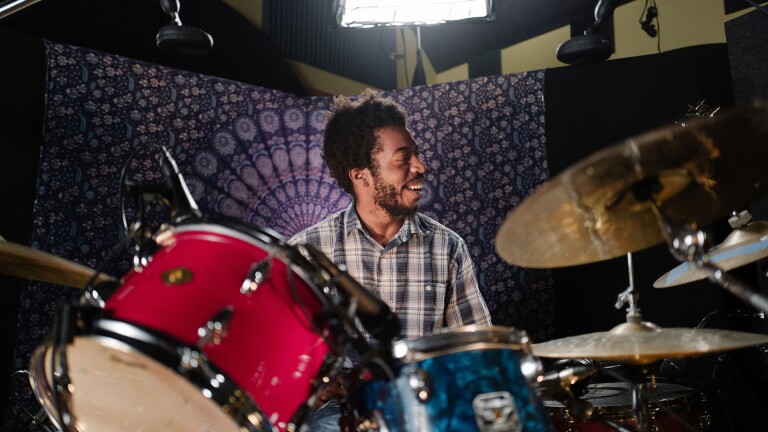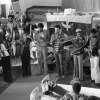Midnight Blue and Beyond: The Evolution of Kenny Burrell's Sound

The premise, as far as recording sessions go, was simple: guitarist Kenny Burrell would lead a quintet at the Van Gelder Studio in Englewood Cliffs, New Jersey. This quintet included bassist Major Holley Jr., drummer Bill English, conga player Ray Barretto while saxophonist Stanley Turrentine, who had joined Burrell alongside organist Jimmy Smith on soul-jazz master classes Midnight Special and Back at the Chicken Shack, played on half of the tunes. Recorded in a single day in January of 1963, "Midnight Blue" was carried by Burrell's soulful guitar — an instrument that served as understated blues band and strummed orchestra. The album would become a best-selling cross-over jazz hit that quickly defined an era. After more than a decade as a first-call guitarist in Detroit and then New York at the time, Burrell had amassed a résumé that is experienced by so few. Whether it was playing with Aretha Franklin, Billie Holiday or Cal Tjader, Burrell was a guiding force in the rhythm section, a dexterous post-bop musician grounded in the elemental roots of the blues. It all started in Detroit.
Burrell is celebrating his 90th birthday this summer. He was born in Detroit, Michigan on July 31, 1931 and grew up surrounded by future jazz legends: pianist Tommy Flanagan, bassist Paul Chambers, the Jones brothers — Hank (piano), Thad (trumpet), Elvin (drums). No other city in America could boast as many innovators in the jazz art form as Detroit and the communal dedication to the sound fostered an environment that was beyond encouraging. By the time he was a teenager, Burrell was fending off offers from some of the most respected artists in his field.
Only 19, Burrell was offered a spot in trumpeter Dizzy Gillespie's band. In 1950, Gillespie was still contending with his partnership with the ill-fated Charlie Parker, his nimble bebop foil after World War II. But Burrell passed on the job. At the advice of his mother, he stayed in school at Wayne State University and finished his education. His mother posited that if Gillespie was interested in Burrell's services then there would be more opportunities for the guitarist by the time he graduated. Burrell's commitment to musical education would become a lifelong pursuit. And his mother was right. By the end of the decade, Burrell could point to recordings with Billie Holiday, Benny Goodman and James Brown as proof of his versatility and soulful adaptability. Those were the gigs he did for hire. The LPs featuring his name were just as plentiful.

Single-day recording sessions in New Jersey were the norm for jazz labels like Blue Note Records and Prestige through the 1950s and 1960s. A band would be assembled through friendships or the whims of a producer. Rarely would the groups be working bands but instead they were often learning the repertoire shortly before hitting the record button. Usually whoever wrote the tune would tell the band how it starts and how it ends. The soloists would fill in the rest. Kenny Burrell did countless recordings in this format, working with innovators like trumpeter Donald Byrd, bassist Paul Chambers and drummers Art Blakey and Kenny Clarke. Sometimes nobody knew who the bandleader was until they saw the name on the album cover. Or in the case of the 1957 session known as The Cats, the album was credited to pianist Tommy Flanagan, Burrell, trumpeter Idrees Sulieman and saxophonist John Coltrane.
Coltrane and Burrell worked together numerous times through the 1950s including a co-leader quintet date in 1958 that featured three Detroiters and three members of Miles Davis' working band. Recording a single album in a day meant a catalog of albums were being created faster than they could be released. The Burrell/Coltrane album was held in the vault for half a decade before it was released and at that point both Burrell and Coltrane had become masters of their crafts, both artists firmly focused on their own richly divergent journeys.
All musicians seek to have their own "sound." It is the great dream of musicians to be identified by the way they play a single phrase, their essence contained in a few well-placed notes. John Coltrane has an unmistakable way of phrasing. Art Blakey can be spotted by a single blast to a snare drum. Kenny Burrell has an immediately recognizable guitar tone. His is warm and controlled. The result is patient and possessed by the essence of the blues. Burrell was never overly flashy or loud on record and by "Midnight Blue" he had mastered the "Kenny Burrell sound."
Aside from the jazz standard "Gee, Baby Ain't I Good to You," all of the tracks on "Midnight Blue" are in-the-pocket blues numbers guided by Burrell's six strings. While Stanley Turrentine lends his honking tenor to half of the record, it coasts on the spacious groove created by Burrell, bassist Major Holley Jr. and drummer Bill English. Ray Barretto's congas are the percussive time capsule, grounding us firmly in 1963 with a churning but unhurried groove.
In 1963, Burrell and Coltrane were still working within the economically-friendly constraints of single-day recording sessions. It worked too well for everyone to pass up but at the same time tinkerers were about to grab hold of studio hours and label budgets. Between 1958 and 1963, Burrell had become a first call soul-jazz guitarist, recording more than a dozen classic albums with organist Jimmy Smith; bright, swinging grooves with wide appeal. Coltrane meanwhile was emerging as the voice of a whole different kind of soul. Coltrane was on a divine mission, exploring the outer reaches of comprehension. While Coltrane was preparing to record "A Love Supreme" in a single recording session in 1964, Phil Spector was spending two days trying to record the vocals on the Righteous Brothers' "You've Lost that Lovin' Feeling," endless studio hours in pursuit of sonic omnipotence. Burrell's "Guitar Forms" album split the difference.
Recorded at New York's Webster Hall in two sessions in mid-December 1964 ("A Love Supreme" was recorded that same week!), "Guitar Forms" was a far grander project. Gil Evans wrote half the arrangements for the moody, large ensemble results. More than a dozen musicians join Burrell as he stretches out not just on the electric guitar but also the acoustic, highlighting his versatility and pushing back against the soul-jazz corner he was in danger of living in. Burrell shows a maturity on the record, the result of countless hours alone with the guitar.
He achieved this by staying local. Rather than touring endlessly like many of his contemporaries, Burrell took several gigs working in Broadway pit orchestras through the 1960s. It took most of his evenings but the work was consistent. He picked up the occasional recording session work (Tony Bennett, Louis Armstrong, Miriam Makeba) but focused mostly on developing his sound, prying open the music and finding where he wanted to go.
Slowly, he got his nights back. He moved to Los Angeles in the early 1970s and began teaching seminars on music between recording dates. In 1978, at UCLA, his "Ellingtonia" course became the first college-level survey of the American composer Duke Ellington. And for the last forty years he has seen an entire global jazz studies build up around his efforts. By the mid-1990s, he had an official jazz studies program at the school. He brought in musicians like Harold Land and Gerald Wilson to share their knowledge. Graduates like Gretchen Parlato and Kamasi Washington were making strides as prominent recording artists. The program now boasts nearly five dozen students committed to the origins of the Black American music form known as jazz. Now retired, Burrell has left a legacy of recordings and educational philosophy that will endure forever. The kid from Detroit did pretty good.
Discography
1956
Swingin'
Introducing Kenny Burrell
Monday Stroll
After Hours -Vol. I
All Night Long
1957
All Day Long
Blue Moods
The Cats
Kenny Burrell [Prestige]
Kenny Burrell, Vol. 2
Kenny Burrell and John Jenkins K.B. Blues
Two Guitars

1958
Kenny Burrell & John Coltrane Blue Lights, Vol. 1
Blue Lights, Vol. 2
Moonglow
1959
On View at the Five Spot Café [live] On View at the Five Spot Café
A Night at the Vanguard [live]
1960
Weaver of Dreams
1961
Bluesin' Around
1962
Bluesy Burrell
Screamin
Out of This World
1963
Midnight Blue
Lotsa Bossa Nova
Freedom
Crash!
Blue Bash

1964
Soul Call
Guitar Forms
1966
The Tender Gender
Soulero
Cool Cookin'
Man at Work [live]
Have Yourself a Soulful Little Christmas
A Generation Ago Today
For Charlie Christian and Benny Goodman
1967
Ode to 52nd Street
Blues —The Common Ground
1968
Night Song
Asphalt Canyon Suite
1971
God Bless the Child
1973
Both Feet on the Ground
1974
Up the Street, `round the Corner Down the Block
1975
Ellington Is Forever, Vol. I
1976
Sky Street
1977
Tin Tin Deo
Ellington Is Forever, Vol. 2
1978
Handcrafted
When Lights Are Low In New York
Live at the Village Vanguard
Stormy Monday
1979
Moon and Sand
1980
Heritage
Listen to the Dawn
1981
For Duke
1983
Ellington a La Carte
1984
Togethering
1986
Generation
Pieces of Blue and the Blues
1989
Guiding Spirit [live]
1990
Recapitulation
All Day Long Vol. 2
1991
Sunup to Sundown
1993
Soft Winds
Master 2
1994
Collaboration La Carte
1995
Lotus Blossom
Primal Blue
Midnight at the Village Vanguard [live]
Gifts
1996
Live at the Blue Note
Then Along Came Kenny [live]
1998
Love Is the Answer Round Midnight
Kenny Burrell and the Jazz Giants
Laid Back
12-15-78
1999
At the Village Vanguard
Kenny Burrell (Giants of Jazz)
2000
Incontournables
Gold Collection
2001
Stormy Monday Blues
Lucky So and So

2002
Moten Swing!
2003
Blue Muse
Earthy
Groovin' High
2004
The Best Of Kenny Burrell
2005
Artist Selects
Prestige Profiles
Ballad Essentials
Solo Live at Boston Court Theatre
2006
In a Mellow Tone
The Ralph J. Bunche Suite
2007
All Night Long/ All Day Long
Delilah
Mess of Blues
2008
Midnight at Detroit
2009
Milt Jackson & The Jazz Giants, Bean Bags plus Bag's Opus
2010
Standards
2012
Blue Note Jazz Inspiration
North, South, East.....Wess
2013
Seven Classic Albums
Desafinado + Bluesy Burrell

2014
Seven Classic Albums Vol. 2
2015
11 Greatest Jazz Hits
Kenny Burrell + Bright's Spot
2016
Complete 1957-59 Sessions
5 Original Albums
The Complete Albums Collection 1957-1962
The Complete Albums Collection 1956-1957
2017
More Jazz Guitar Milestones Of Jazz Legends
2018
Four Classic Albums
2019
Complete Studio Sessions
2020
Verve Wishes You A Swinging Christmas
Source: "Kenny Burrell: A Life in Music;" Discogs.com






